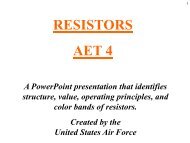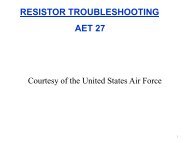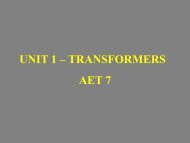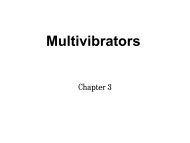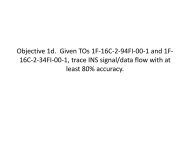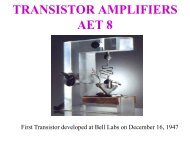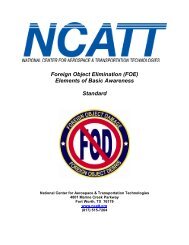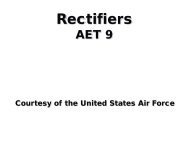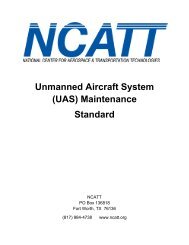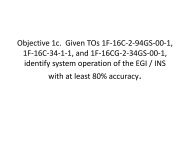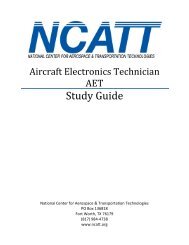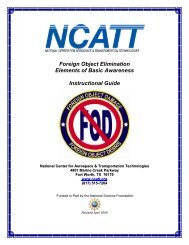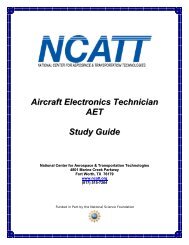(AET) Study Guide - NCATT
(AET) Study Guide - NCATT
(AET) Study Guide - NCATT
- No tags were found...
You also want an ePaper? Increase the reach of your titles
YUMPU automatically turns print PDFs into web optimized ePapers that Google loves.
Page 43 of 51oDigital Multimeter—Measured as ohms/volts. Digital multimeters allow for thelargest allowable error that can occur under a specific condition. Allowable error isan indication of how close a meter’s displayed value is to the actual value of thesignal being measured.Content – Oscilloscopes:Oscilloscopes are basic instruments for analyzing digital data signals. Explain and demonstratehow to properly connect and use an oscilloscope to display voltage levels and frequency withreference to the following terms:• Oscilloscopes—Electronic test instrument that displays the waveforms of electricalsignals. Oscilloscopes measure voltages (AC peak-to-peak values) and time to determinefrequencies. An oscilloscope displays phase relationships (comparisons of waveforms intime) to identify equipment malfunctions.• RF and Microwave Measurement—Use the following test equipment:o Analog Oscilloscopes—Amplify the signal measured and display the signal at aspecific sweep rate.o Digital Oscilloscopes—Use high-speed sampling to convert the signal measured intoa series of “digital words” that are stored in the memory of the oscilloscope.Aircraft Fundamentals25. Aviation Terminology <strong>NCATT</strong> Training Standard Level (A)Objective:Identify basic facts and terms about aircraft design and construction techniques.Content – Aviation Terminology:Explain basic aviation facts and terminology with reference to the following terms:• Fuselage—Central area of aircraft aft of the firewall and forward of the empennage. Thisarea contains the cockpit or cabin. Depending on the size of the aircraft, there may beareas for passengers, cargo, and other aircraft components. Two types of fuselages are thefollowing:o Monocoque—Most common type of fuselage design. Monocoque fuselages haveofewer internal parts and more highly stressed skin.Semimonocoque—Derives its strength from internal parts such as bulkheads,longerons, keel beams, and drag struts.• Wings—Airfoil framework mainly of spars, ribs, and sometime stringers attached to thefuselage. Wings generate lift in flight, and the wing spars carry the load through thefuselage to the other wing. Wing structures include the following:ooCantilever—Most common and strongest type of wing design. The wings areattached directly to the fuselage without any external, stress-bearing structures. Asingle large beam, the main spar, runs through the wing for internal bracing. Wingsobtain their entire strength from their internal structural elements.Semi-cantilever—Supported by one or two supporting wires or struts extendingbetween each wing and the fuselage for external bracing.Copyright © 2008 by the National Center for Aircraft Technician Training. All rights reserved.Individuals may download, print, and make copies of this documentfor their own personal use. Commercial use prohibited.



